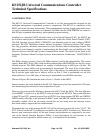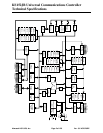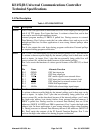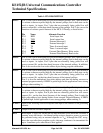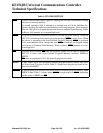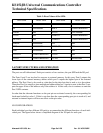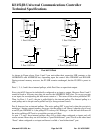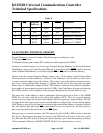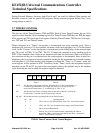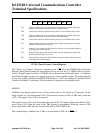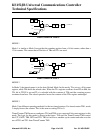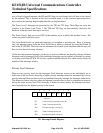
KS152JB Universal Communications Controller
Technical Specifications
Kawasaki LSI USA, Inc. Page 1 of 120 Ver. 0.9 KS152JB2
1.0 INTRODUCTION
The 80C152 Universal Communications Controller is an 8-bit microcontroller designed for the
intelligent management of peripheral systems or components. The 80C152 is a derivative of the
80C51 and retains the same functionality. These enhancements include: a high speed multi-proto-
col serial communication interface, two channels for DMA transfers, HOLD/HLDA bus control, a
fifth I/O port, expanded data memory, and expanded program memory.
In addition to a standard UART, referred to here as Local Serial Channel (LSC), the 80C152 has
an on-board multi-protocol communication controller called the Global Serial Channel (GSC).
The GSC interface supports SDLC, CSMA/CD, user definable protocols, and a subset of HDLC
protocols. The GSC capabilities include: address recognition, collision resolution, CRC genera-
tion, flag generation, automatic retransmission, and a hardware based acknowledge feature. This
high speed serial channel is capable of implementing the Data Link Layer and the Physical Link
Layer as shown in the OSI open systems communication model. This model can be found in the
document “Reference Model for Open Systems Interconnection Architecture”, ISO/TC97/SC16
N309.
The DMA circuitry consists of two 8-bit DMA channels with 16-bit addressability. The control
signals; Read (RD), Write (WR), hold and hold acknowledge (HOLD/HLDA) are used to access
external memory. The DMA channels are capable of addressing up to 64K bytes (16 bits). The
destination or source address can be automatically incremented. The lower 8 bits of the address
can be automatically incremented. The lower 8 bits of the address are multiplexed on the data bus
Port 0 and the upper eight bits of address will be on Port 2. Data is transmitted over an 8-bit
address/data bus. Up to 64k bytes of data may be transmitted for each DMA activation.
The new I/O port (P4) function the same as Ports 1-3 found on the 80C51.
Internal memory has been doubled in the 80C152. Data memory has been expanded to 256 bytes,
and internal program memory has been expanded to 8 bytes.
There are also some specific differences between the 80C152 and the 80C51. The first difference
is that RESET is active low in the 80C152 and active high in the 80C51H. The second difference
is that GF0 and GF1, general purpose flags in PCON, have been renamed GFIEN and XRCLK.
GFIEN enables idle flags to be generated in SDLC mode, and XRCLK enables the receiver to be
externally clocked. All of the previously unused bits are now being used and interrupt vectors
have been added to support the new enhancements.
Throughout the rest of this manual the 80C152 will be referred to generically as the “C152”. The
C152 is based on the 80C51 architecture and utilizes the same 80C51 instruction set. There have
been no new instructions added. All the new features and peripherals are supported by an exten-
sion of the Special Function Registers (SFRs). A brief information on cpu functions as: the
instruction set, port operation, timer/counters, etc., is included in this document.



